
Sometimes foraging takes you up. Photo by Green Deane
Foraging occasionally is not for the faint of heart. Sometimes you have to climb trees or diving ditches. The reward is free treasure. After Sunday’s class we visited four loquat trees and took home a bounty… standing on vehicles to get the top fruit. Then we went exploring for watercress, finding a lot of basswood trees in the process. Use their leaves like lettuce.
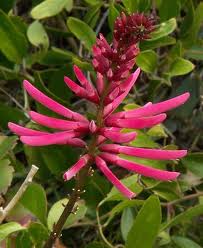
Eastern Coral Beans are easy to find this time of year. Photo by Green Deane
Every Spring another edible is easy to identify: Coral bean, or Eastern Cherokee Bean, which is semi-toxic. It’s blossoming habit reveals its hiding places. The blossoms are edible raw in moderation or cooked. They have a long history in central American cuisine. The problem is the beans the blossom create are dangerous and should not be eaten. Young leaves cooked are also edible. As one might suspect the shrub attracts humming birds. It is wind and salt tolerant and is a common find on barrier islands, near the beaches. A Japanese study published in the Journal of Natural Medicines, 29 Jan 2008, confirmed six antioxidants in the coral bean flower. I boil flowers for 15 minutes in plenty of water. They turn green and limp when cooked and reduce in size so collect a lot. The flavor is mild, like young spinach. You can read about it here.
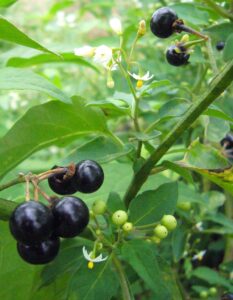
Ripe Americanum solanum berries are edible. Photo by Green Deane
We’ve also seen a lot of fruiting American Nightshade. While the ripe berries are edible many have learned that they are toxic so it remains a controversial plant. There are basically three reasons why the plant is controversial. Early American botanists made a lot of assumption about the species presuming they were toxic like European species. Complicating the issue was a proliferation of botanical names over the centuries so it was difficult for researchers to know if they were discussing the same plant. And the unripe berries can make you ill. What I look for when identifying this species is green shiny berries that a mottled and flecked with white. They ripen to dark purple. They are all at the end of the peduncle (stem.) It also has blossoms which occasionally go backwards, see photo left.
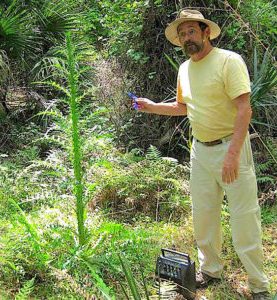
Foraging classes are held rain or shine, heat or cold. Photo by Nermina Krenata
Foraging Classes: Weather this month should be good for foraging and it is a prime time of year to look for wild edible.
Saturday March 11th, Blanchard Park, 2451 Dean Rd, Union Park, FL 32817, 9 a.m. meet by the tennis courts.
Sunday March 12th,Boulware Springs Park, 3420 SE 15th St., Gainesville, FL 32641. Meet at the pavilion by the pump house. 9 a.m.
Saturday March 18th, Wickham Park: 2500 Parkway Drive, Melbourne, FL. Meet at the “dog park” inside the park 9 a.m.
Sunday March 19th, Bayshore Live Oak Park Park, Bayshore Drive, Port Charlotte, Meet at the parking lot at Bayshore and Ganyard Street. 9 a.m.
Saturday March 25th, Mead Garden, 1500 S. Denning Dr., Winter Park, FL 32789. Meet at the bathrooms. 9 na.m.
Sunday March 26th, Eagle Lake Park, 1800 Keene Road, Largo, FL 33771. Meet at the pavilion near the dog park. 9 a.m.
Bring cash on the day of class or click here to pay for your class
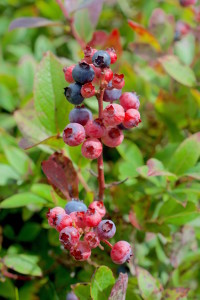
Blueberries, Roan Mt. North Carolina.
It’s not June that’s busting out all over but rather Vacciniums, mostly blueberries. Last week I had the opportunity to see V. elliottii in south Georgia. This Sunday we saw V. myrsinites and V. darrowii in bloom. Expect ripe berries in a month to six weeks. Blackberries were also in full bloom this week. They also usually are ripe sometime in April. And if we get ten days of good rain in the next three weeks look for a second flush of Ringless Honey Mushrooms. The seasons are not static.
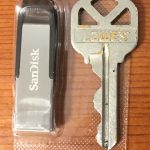
You get the USB, not the key.
My nine-DVD set of 135 videos has been phased out and replaced by 171-videos on a 128-GB USB, see right. The USB videos are the same videos I have on You Tube. Some people like to have their own copy especially if social order falters. The USB videos have to be copied to your computer to play. If you want to order the USB go to the DVD/USB order button on the top right of this page or click here. That will take you to an order form. Or you can make a $99 donation, which tells me it is for the USB (include a snail-mail address.) I’d like to thank all of you who ordered the DVD set over the years which required me to burn over 5,000 DVDs individually. I had to stop making them as few programs now will read the ISO files to copy them. Burning a set also took about three hours.

Green Deane Forum
Want to identify a plant? Perhaps you’re looking for a foraging reference? You might have a UFO, an Unidentified Flowering Object, you want identified. On the Green Deane Forum we — including Green Deane and others from around the world — chat about foraging all year. And it’s not just about warm-weather plants or just North American flora. Many nations share common weeds so there’s a lot to talk about. There’s also more than weeds. The reference section has information for foraging around the world. There are also articles on food preservation, and forgotten skills from making bows to fermenting food. Recent topics include: Stale Bread and Cod Liver Oil, Killing Bugs with Tobacco Plugs, Eating weeds: Is it safe? Have they mutated? Not the Eastern Red Bug but the Pink Tabebuia, African Tulip Tree, Asparagus densiflorus, Green Deane’s Book… You can join the forum by clicking on the button on the upper right hand side of this page.
This is my weekly newsletter #548. If you want to subscribe to this free newsletter you can find the sign-up form in the menu at the top of the page. My website, EatTheWeeds.com, which is data secure, has over 1500 plants on it in some 428 articles. I wrote every one myself, no cut and paste.
To donate to the Green Deane Newsletter click here.

